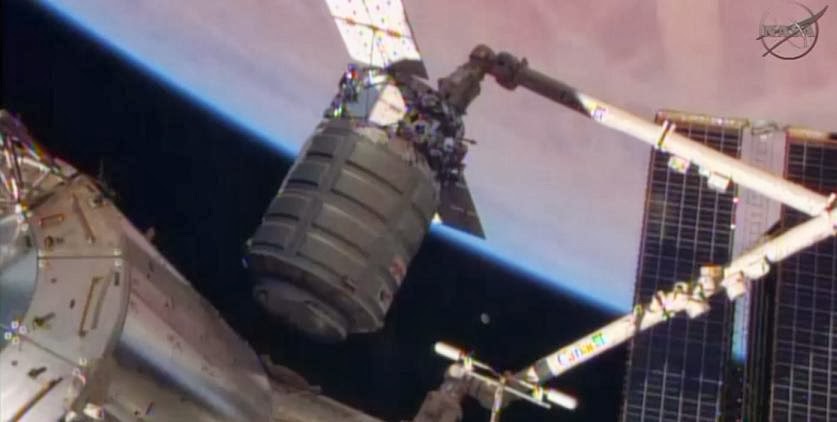 The Cygnus spacecraft carrying the 23 SSEP Mission 3b and Mission 4 experiments was captured by Canadarm2 at the International Space Station at 6:08 am ET, Sunday, January 12, 2014. Cygnus was berthed at the Station’s Harmony node at 8:05 am ET.
The Cygnus spacecraft carrying the 23 SSEP Mission 3b and Mission 4 experiments was captured by Canadarm2 at the International Space Station at 6:08 am ET, Sunday, January 12, 2014. Cygnus was berthed at the Station’s Harmony node at 8:05 am ET.
The Mission 3b Falcon II and Mission 4 Orion payloads were transferred to station, and 10 of 23 experiments were activated between 7:20 am and 7:40 am ET, Monday, January 13, 2014, by astronaut Koichi Wakata. January 13 is therefore designated as day Arrival =0. On January 15, designated as day Arrival+2, three more experiments are to be activated and two will be de-activated.
Below is the NanoRacks communique received by the Arthur C. Clarke Institute for Space Education, and the National Center for Earth and Space Science Education at 10:25 am ET, January 13, providing the details of these on-orbit activities. The Center then posted all details on the SSEP Mission 4 and 3b to ISS: Experiment Log page, and alerted all student flight teams by 12:12 pm ET. Details of activities on ISS were therefore communicated to flight teams less than 5 hours after they occurred.
Flight teams are using the information provided on the Log page to carry out concurrent ground truth experiments. Conducting identical experiments on the ground is critical. Once the flight experiment is returned to Earth, an analytical comparison with the ground experiment allows the role of gravity to be assessed for the physical, chemical, or biological system under study.
NanRacks Communique
NanoRacks Module 9 S/N 1008, 1010, and 1011 Payload Science Status Report
Increment: 38
Mission Day: GMT 013
Originator: Rob Alexander
Date: January 13, 2014
Science Status: Koichi Wakata activated the following NanoRacks Mixuture Tubes on orbit today.
The following experiments were activated:
At 6:20 AM CST (1220 GMT)
S/N 1008, Tube 7:Lactobacillus Bacteria Growth in Microgravity
At 6:30 AM CST (1230 GMT)
S/N 1010, Tube 1: Mammalian Milk in Microgravity
S/N 1010, Tube 2: Kidney Stone Growth in Space
S/N 1010, Tube 3: Does microgravity affect the growth of a Glycine max plant?
S/N 1010, Tube 5: How does bacterial growth and subsequent decay of enamel on pig teeth differ in a microgravity environment compared to on Earth?
At 6:40 AM CST (1240 GMT)
S/N 1011, Tube 1: Aleve XR and Encapsulation in Microgravity
S/N 1011, Tube 2: What Are the Effects of Creation of Beer in Microgravity and is it Possible?
S/N 1011, Tube 3: The Effect of Microgravity on Calcium Absorption by Bones
S/N 1011, Tube 5: The Effect of Microgravity on the Oxidation of Metal Exposed to a Salt Water Solution differ in a microgravity environment compared to on Earth?
S/N 1011, Tube 8: The Formation of Silver Crystals in Microgravity
More information about these experiments can be found at the following links:
http://ssep.ncesse.org/communities/experiments-selected-for-flight/selected-experiments-on-ssep-mission-3-to-iss/
http://ssep.ncesse.org/communities/experiments-selected-for-flight/selected-experiments-on-ssep-mission-4-to-iss/
Unexpected Events: N/A
Science Look Ahead: The next crew interaction will be on GMT 015 (January 15). The following tubes will be activated:
S/N 1008, Tube 4: Will Microgravity Alter the Regeneration of Dugesia Tigrina?
S/N 1011, Tube 6: How does microgravity effect the mold growth on bread?
S/N 1011, Tube 7: Dehydrated and Live Tardigrades Vs. Microgravity
The following tubes will be deactivated:
S/N 1008, Tube 7:Lactobacillus Bacteria Growth in Microgravity
S/N 1011, Tube 1: Aleve XR and Encapsulation in Microgravity
The following tubes will be shaken:
The following tubes will be deactivated
S/N 1010, Tube 1: Mammalian Milk in Microgravity
S/N 1011, Tube 5: The Effect of Microgravity on the Oxidation of Metal Exposed to a Salt Water Solution differ in a microgravity environment compared to on Earth?
Topics for resolution: N/A
The Student Spaceflight Experiments Program (SSEP) is a program of the National Center for Earth and Space Science Education (NCESSE) in the U.S., and the Arthur C. Clarke Institute for Space Education internationally. It is enabled through a strategic partnership with NanoRacks LLC, working with NASA under a Space Act Agreement as part of the utilization of the International Space Station as a National Laboratory. SSEP is the first pre-college STEM education program that is both a U.S. national initiative and implemented as an on-orbit commercial space venture.
The Smithsonian National Air and Space Museum, Center for the Advancement of Science in Space (CASIS), Carnegie Institution of Washington, NASA Nebraska Space Grant Consortium, and Subaru of America, Inc. are National Partners on the Student Spaceflight Experiments Program.



